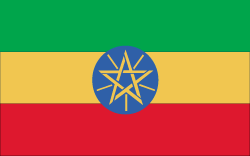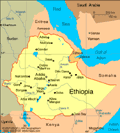Ethiopia
 |
Geography
Ethiopia is in east-central Africa, bordered on the west by the Sudan, the east by Somalia and Djibouti, the south by Kenya, and the northeast by Eritrea. It is nearly three times the size of California. Over its main plateau land, Ethiopia has several high mountains, the highest of which is Ras Dashan at 15,158 ft (4,620 m). The Blue Nile, or Abbai, rises in the northwest and flows in a great semicircle east, south, and northwest before entering the Sudan. Its chief reservoir, Lake Tana, lies in the northwest part of the plateau.
Government
Federal republic.
History
Archeologists have found the oldest known human ancestors in Ethiopia, including Ardipithecus ramidus kadabba (c. 5.8–5.2 million years old) and Australopithecus anamensis (c. 4.2 million years old). Originally called Abyssinia, Ethiopia is sub-Saharan Africa's oldest state, and its Solomonic dynasty claims descent from King Menelik I, traditionally believed to have been the son of the queen of Sheba and King Solomon. The current nation is a consolidation of smaller kingdoms that owed feudal allegiance to the Ethiopian emperor.
Hamitic peoples migrated to Ethiopia from Asia Minor in prehistoric times. Semitic traders from Arabia penetrated the region in the 7th century B.C. Its Red Sea ports were important to the Roman and Byzantine Empires. Coptic Christianity was brought to the region in A.D. 341, and a variant of it became Ethiopia's state religion. Ancient Ethiopia reached its peak in the 5th century, then was isolated by the rise of Islam and weakened by feudal wars.
Modern Ethiopia emerged under Emperor Menelik II, who established its independence by routing an Italian invasion in 1896. He expanded Ethiopia by conquest. Disorders that followed Menelik's death brought his daughter to the throne in 1917, with his cousin, Tafari Makonnen, as regent and heir apparent. When the empress died in 1930, Tafari was crowned Emperor Haile Selassie I.
Haile Selassie, called the “Lion of Judah,” outlawed slavery and tried to centralize his scattered realm, in which 70 languages were spoken. In 1931, he created a constitution, revised in 1955, that called for a Parliament with an appointed senate and an elected chamber of deputies, and a system of courts. But basic power remained with the emperor.
Fascist Italy invaded Ethiopia on Oct. 3, 1935, forcing Haile Selassie into exile in May 1936. Ethiopia was annexed to Eritrea, then an Italian colony, and to Italian Somaliland, forming Italian East Africa. In 1941, British troops routed the Italians, and Haile Selassie returned to Addis Ababa. In 1952, Eritrea was incorporated into Ethiopia.
On Sept. 12, 1974, Haile Selassie was deposed, the constitution suspended, and Ethiopia proclaimed a socialist state under a collective military dictatorship called the Provisional Military Administrative Council (PMAC), also known as the Derg. U.S. aid stopped, and Cuban and Soviet aid began. Lt. Col. Mengistu Haile Mariam became head of state in 1977. During this period Ethiopia fought against Eritrean secessionists as well as Somali rebels, and the government fought against its own people in a campaign called the “red terror.” Mengistu remained leader until 1991, when his greatest supporter, the Soviet Union, dismantled itself.
A group called the Ethiopian People's Revolutionary Democratic Front seized the capital in 1991, and in May a separatist guerrilla organization, the Eritrean People's Liberation Front, took control of the province of Eritrea. The two groups agreed that Eritrea would have an internationally supervised referendum on independence. This election took place in April 1993 with almost unanimous support for Eritrean independence. Ethiopia accepted and recognized Eritrea as an independent state within a few days. Sixty-eight leaders of the former military government were put on trial in April 1996 on charges that included genocide and crimes against humanity.
Since Eritrea's independence, Eritrea and Ethiopia had disagreed about the exact demarcation of their borders, and in May 1998 Eritrea initiated border clashes that developed into a full-scale war that left tens of thousands dead and further destroyed both countries' ailing economies. After a costly and bloody two-year war, a permanent cease-fire was reached in June 2000—Ethiopia had the upper hand when the fighting ceased—and a formal peace agreement was signed in Dec. 2000. The United Nations has provided several thousand peacekeeping forces to patrol the buffer zone between the two nations until a permanent border can be agreed upon. Prime Minister Zenawi's political backing has eroded somewhat since the war—hardliners, who felt he had been too soft on Eritrea, have tried to unseat him.
Federal Democratic Republic of Ethiopia
President: Girma Wolde-Giyorgis (2001)
Prime Minister: Meles Zenawi (1995)
Area: 435,184 sq mi (1,127,127 sq km)
Population (2001 est.): 65,891,874 (average annual rate of natural increase: 2.7%); birth rate: 44.7/1000; infant mortality rate: 100.0/1000; density per sq mi: 151
Capital and largest city (1993 est.): Addis Ababa, 2,200,186
Monetary unit: Birr
Languages: Amharic (official), English, Orominga, Tigrigna, over 70 languages spoken
Ethnicity/race: Oromo 40%, Amhara and Tigrean 32%, Sidamo 9%, Shankella 6%, Somali 6%, Afar 4%, Gurage 2%, other 1%
Religions: Ethiopian Orthodox 35%–40%, Islam 40%–45%, animist 15%–20%, other 5%
Literacy rate: 28% (1984)
Economic summary: GDP/PPP (1999 est.): $33.3 billion; per capita $560. Real growth rate: 0%. Inflation: 4%. Unemployment: n.a. Arable land: 12%. Agriculture: cereals, pulses, coffee, oilseed, sugarcane, potatoes; hides, cattle, sheep, goats. Labor force: n.a; agriculture and animal husbandry, 80%; government and services, 12%; industry and construction, 8% (1985). Industries: food processing, beverages, textiles, chemicals, metals processing, cement. Natural resources: small reserves of gold, platinum, copper, potash, natural gas, hydropower. Exports: $420 million (f.o.b., 1998): coffee, gold, leather products, oilseeds. Imports: $1.25 billion (f.o.b., 1998 est.): food and live animals, petroleum and petroleum products, chemicals, machinery, motor vehicles. Major trading partners: Germany, Japan, Italy, UK, U.S., Jordan.
Communications: Telephones: main lines in use: 365,000 (1999); mobile cellular: 4,000 (1999). Radio broadcast stations: AM 5, FM 0, shortwave 2 (1999). Radios: 11.75 million (1997). Television broadcast stations: 25 (1999). Televisions: 320,000 (1997). Internet Service Providers (ISPs): 1 (1999).
Transportation: Railways: total: 681 km (Ethiopian segment of the Addis Ababa-Djibouti railroad). Highways: total: 28,500 km; paved: 4,275 km; unpaved: 24,225 km (1996 est.). Ports and harbors: none; Ethiopia is landlocked and was by agreement with Eritrea using the ports of Assab and Massawa; since the border dispute with Eritrea flared, Ethiopia has used the port of Djibouti for nearly all of its imports. Airports: 85 (1999 est.).
International disputes: most of the southern half of the boundary with Somalia is a Provisional Administrative Line; territorial dispute with Somalia over the Ogaden; dispute over alignment of boundary with Eritrea led to armed conflict in 1998, which is still unresolved despite arbitration efforts.
